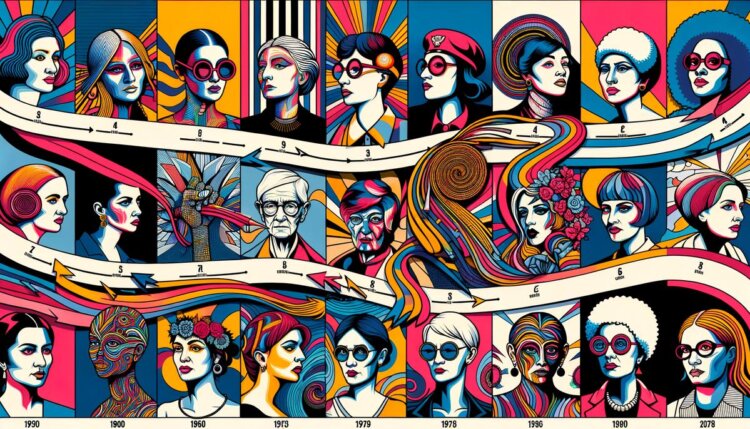Historical Context and Emergence
Feminist art theory emerged in the late 1960s and 1970s, a time of political activism and social change. Women artists began to challenge their exclusion from art history and the art world. Linda Nochlin's 1971 essay "Why Have There Been No Great Women Artists?" was a pivotal moment, questioning societal structures that had limited women's participation in art.
Nochlin's work inspired other feminist art historians like Lise Vogel and Griselda Pollock to reexamine art history through the lens of gender, race, and class. They sought to uncover forgotten women artists and rewrite the historical narrative.
In studios and galleries, feminist artists created works that confronted gender inequalities. Projects like Womanhouse, initiated by Judy Chicago and Miriam Schapiro, reimagined domestic spaces as sites of artistic expression. The Guerrilla Girls used humor and anonymity to critique the lack of representation of women in galleries and museums.
This movement built on the legacy of earlier women artists like Frida Kahlo and Käthe Kollwitz, who had paved the way with their own rebellious spirits. Feminist art theory became a force for inclusion, challenging established norms and redefining art's boundaries.
Key Debates and Critiques
As feminist art theory developed, it sparked several key debates. One central discussion was the essentialism controversy, which questioned whether there was an inherent "female aesthetic" in art. Some embraced this idea, while others, like Renee Sandell, warned against its potentially limiting effects.
Griselda Pollock argued that simply adding women to the existing art canon wasn't enough. She called for a complete dismantling of gender constructs in art history. Mary D. Garrard further emphasized the importance of intersectionality, highlighting how race, class, and gender interact in artistic discourse.
These debates enriched the field, allowing for a diversity of perspectives and approaches. They pushed feminist art theory beyond binary gender paradigms and towards a more complex understanding of identity in art. As the field continues to evolve, it remains a space for challenging traditions and fostering innovation in art history and criticism.
Influential Artworks and Artists
Feminist artists have created powerful works that challenge societal norms and redefine art. Judy Chicago's "The Dinner Party" (1974-1979) stands out as a collaborative installation celebrating women's historical contributions. Its distinctive ceramic plates with butterfly and vulva designs assert a visual language of femininity.
Carolee Schneemann's "Interior Scroll" (1975) performance piece boldly rejected the male gaze, literally extracting a scroll from her body to highlight women's autonomy. Lynda Benglis's controversial ArtForum advertisement similarly confronted traditional depictions of femininity.
Miriam Schapiro's "femmages," like "Anatomy of a Kimono," blended high and low art forms, challenging the gendered hierarchy of materials. The Guerrilla Girls used humor and public campaigns to expose exclusionary practices in the art world.
These artists and their works embodied a spirit of rebellion, using diverse media and approaches to dismantle oppressive structures. They proved that art could be a catalyst for societal change, reshaping the creative landscape and paving the way for future generations of artists to explore new forms of expression.
Impact on Art Education and Institutions
Feminist art theory has significantly influenced art education and institutions, diversifying curricula and challenging male-centric interpretations. Universities and art schools have introduced courses that infuse gender perspectives into traditional art history. Pioneering programs like the Feminist Art Program, founded by Judy Chicago and Miriam Schapiro, provided platforms for marginalized voices.
Efforts to increase the visibility of women artists in academic textbooks have shown progress, as revealed by studies like those of Roger Clark. Museums have also embraced feminist perspectives, transforming curatorial practices and hosting significant exhibitions focused on women artists.
Despite these advances, challenges remain. The fight for full representation and inclusion is ongoing, particularly for non-Western and diverse artists. The art community must continue to advocate for reform to ensure a more comprehensive understanding of art's history and its creators.
Contemporary Developments and Future Directions
Feminist art theory continues to evolve, incorporating new perspectives and global voices. Autotheory has emerged as a significant trend, blending personal experiences with critical discourse. Writers and artists like Lauren Elkin use this approach to explore themes of female embodiment, breaking down barriers between artist and audience.
Globally, feminist art is thriving through cross-cultural dialogues and intersectional perspectives. Artists from diverse backgrounds are using feminist discourse to tell nuanced stories reflecting complex identities shaped by race, class, gender, and geography. This expansion challenges Western-centric art narratives and promotes a plurality of voices and artistic expressions.
Intersectionality, championed by thinkers like Kimberlé Crenshaw, continues to shape feminist art. This approach encourages practitioners to explore the layers of identity and power dynamics that intersect in personal and political spheres. Contemporary feminist artists create works that challenge simplistic categorizations and celebrate the complexity of human experience.
Looking ahead, digital platforms and emerging technologies offer new tools for exploration and engagement. These advancements enable artists to craft immersive experiences and reach wider audiences. Art institutions are also evolving to foster more inclusive environments that champion diverse stories.
Feminist art theory remains committed to transformative change, encouraging us to consider art's potential not just as a reflection of society but as a canvas for imagining new possibilities. As artists, scholars, and audiences unite around this vision, feminist art's continued evolution promises to enrich our collective consciousness and inspire positive change.
Feminist art theory has reshaped stories, challenged conventions, and opened doors for countless artists to express their truths. This ongoing journey of transformation and inclusion reminds us that art is a powerful tool for change, urging continued advocacy for a more equitable and inclusive world.























